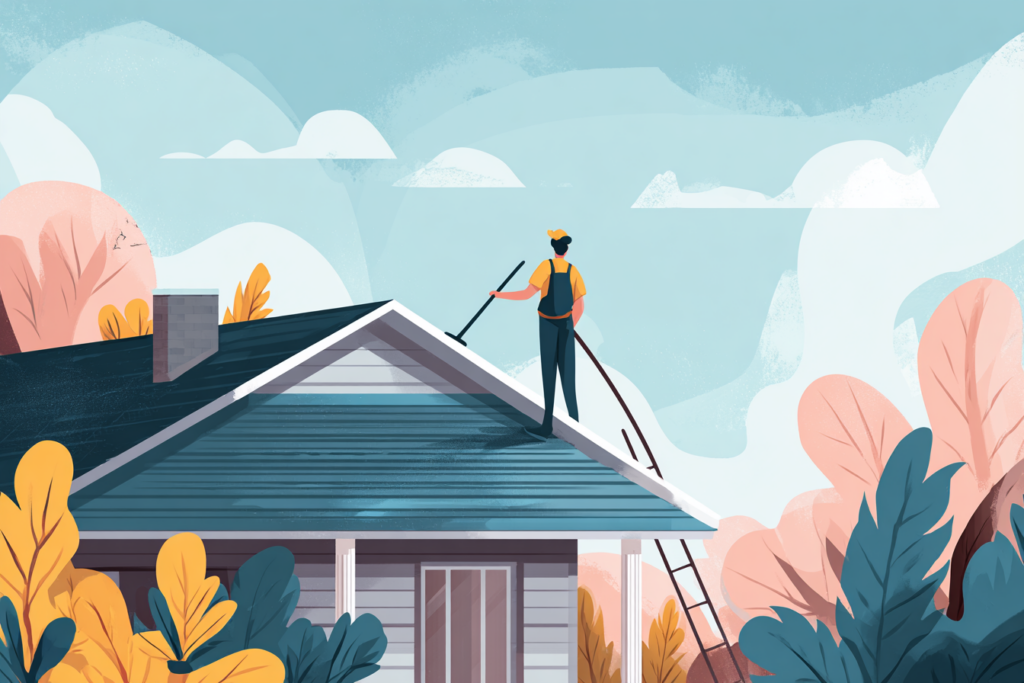When was the last time you gave your roof some serious care and attention? If it was the last time you had a leak, you’re ignoring one of the main protections you have against the elements. There are a few things you should do to keep your roof in good condition with every change of the season. Routine seasonal roof maintenance not only protects your investment but also extends the lifespan of your roofing system. Whether you’re battling snow in the winter or heat waves in the summer, knowing how to prepare your roof for each season helps you avoid costly repairs and unexpected damage.
Here’s your seasonal roadmap for keeping your roof in excellent shape all year long.
Spring: Repair and Refresh After Winter
Spring is often the wettest time of the year, and one where you spend more time on home renewal projects due to the damage winter can leave behind. During spring rains and thaw, it’s time to:
- Inspect shingles and flashing for damage caused by ice dams or high winds. Repair or completely replace any damaged or missing shingles, stat.
- Check attic ventilation for areas with high moisture. Dryers and bathrooms can release a significant amount of humidity into your attic.
- Check for animal nests. Birds and rodents may have moved into your attic for the winter.
Spring is also an ideal time to schedule your annual professional roof inspection, as it’s the season before most major storms begin to roll through.
Summer: Defend Against Sun and Storms

The crack of thunder and high temperatures both mean one thing: possible damage to your roof. Excessive sun exposure can age your skin and your roofing materials. So, slather on the sunscreen and put these summer roofing maintenance tasks on your to-do list:
- Look for signs of excessive sun damage, such as faded shingles, warping or blistering.
- Check your attic insulation and ventilation. Make sure your attic is well-ventilated to keep heat moving outside and to help lower your cooling costs.
- Secure loose flashing and sealant around vents, skylights and chimneys.
- Trim your trees, eliminate any branches overhanging your roof that could come down during a summer squall.
Summer is also the ideal season for more involved roofing projects, such as replacing old shingles or updating flashing. Warm weather and limited rainfall mean you can get the work done without rain delays, and materials cure faster in the heat.
Fall: Prepare for Falling Leaves and Cold Weather
Autumn is full of beautiful weather and a stunning color palette of leaves, but that soon-to-fall foliage is just another task waiting to happen. Use the fall to prepare your home for winter by:
- Clearing gutters regularly to prevent water from backing up and avoid ice dams. Later in the winter
- Install gutter guards to minimize maintenance and keep debris out of your gutters.
- Look for greenery growing on your roof, particularly in shady areas.
- Seal any gaps or holes to keep out moisture and prevent pests from nesting.
- Check the roof flashing—especially in valleys and around chimneys—for any signs of deterioration.
Winter: Prevent Ice Dams and Snow Load Stress
Watch for damage in the winter, but keep your ladders in storage. Roofers consistently make the most dangerous jobs list for a reason, and that reason is falling. Avoid working on snowy or icy roofs whenever possible. To keep your roof functioning through the winter, keep your roofer on speed dial and use tools that don’t require you to stand on your roof. Some examples of safe winter maintenance might include:
- Using a roof rake to safely remove excess snow from the roof edge and prevent ice dams from forming.
- Checking attic insulation to minimize heat loss. Uneven roof snow melt is often caused by heat escaping from a poorly insulated attic.
- Inspecting for icicles and ice ridges. These can indicate underlying issues with ventilation or drainage.
Avoid walking on a snowy or icy roof—besides being dangerous, it can damage brittle shingles. If you suspect a problem, contact a professional who’s experienced with winter roof repairs.
Bonus Tips: Year-Round Best Practices
While seasonal tasks vary, some roofing habits should be on your to-do list every few months:
- Document roof inspections and repairs. Keeping a detailed record can be helpful for insurance claims and resale value.
- Use binoculars to check your roof from the ground. Look for signs of sagging, discoloration, or debris accumulation.
- Watch your ceilings. Any sign of water intrusion—such as stains, musty odors or bubbling paint—warrants a closer inspection.
Being proactive with roof care isn’t just smart—it’s cost-effective. Most major repairs stem from small problems that go unchecked. Staying on top of seasonal maintenance is the best way to avoid those surprise expenses.
Don’t Wait for a Leak
Did you know that the average cost of a roof replacement exceeds $9,000? Depending on the size and materials required for your roof, replacement could cost $ 50,000 or more. Delaying such a major expense by even a few years can help you stay on budget. Invest a few hours in every season to keep your roof weathertight and in good condition for as long as possible.
You might also be interested in: Top Roofing Safety Tips to Prevent Falls and Accidents




